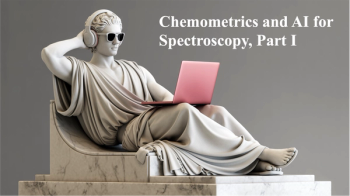
Analyzing Art with Lasers
Lasers have many different scientific uses. Some analytical scientists are advancing the use of laser-based techniques to analyze works of art and other ancient artifacts. Laser-ablation surface-enhanced Raman microspectroscopy (LA-SERS) can analyze art and artifacts to accurately identify the various components inside them. Spectroscopy recently spoke with Pablo Londero, an Associate Conservation Scientist at the Institute for the Preservation of Cultural Heritage (IPCH) at Yale University, and Marco Leona, the head of scientific research at the Metropolitan Museum of Art, about their work in this area.
Lasers have many different scientific uses. Some analytical scientists are advancing the use of laser-based techniques to analyze works of art and other ancient artifacts. Laser-ablation surface-enhanced Raman microspectroscopy (LA-SERS) can analyze art and artifacts to accurately identify the various components inside them. Spectroscopy recently spoke with Pablo Londero, an Associate Conservation Scientist at the Institute for the Preservation of Cultural Heritage (IPCH) at Yale University, and Marco Leona, the head of scientific research at the Metropolitan Museum of Art, about their work in this area.
How do methods using LA-SERS differ from traditional SERS methods for analyzing works of art? What are the advantages and disadvantages of LA-SERS?Londero: SERS signals occur when molecules of interest attach to plasmonic surfaces, and then emit characteristic signals when these surfaces are probed with laser light. LA-SERS differs from traditional SERS primarily in the sampling method, the manner in which the molecules are brought into contact with the plasmonic surface so that they can then be detected. By using laser desorption (or sometimes in our papers we’ve called this “ablation in the desorption regime”), we get finer spatial resolution and more robust sampling (sampling that works for many different kinds of materials) than with other SERS approaches. And by combining this laser desorption with a planar nano-island film as the SERS-active plasmonic surface, we achieve more efficient deposition compared to the methods most commonly used in heritage science (gels and colloids).
Finally, because our design can be integrated with a microscope, one can visualize the sample and precisely target the region to be sampled. This is critical for complex samples that can vary dramatically over several micrometers, and for combining the LA-SERS data with imaging techniques performed on the same sample (for example, scanning electron microscopy [SEM] with energy dispersive X-ray spectroscopy [EDS], Raman, Fourier transform-infrared [FT-IR] spectroscopy, and more).
What approach do you use to ensure that the samples you test represent the whole test subject in the LA-SERS process? In other words, how do you deal with the heterogeneous nature of works of art? Londero: This is always a challenging issue in this field, and how well it can be dealt with depends on the nature of each art object and of the samples taken, on a case-by-case basis. But there are various ways we seek to develop confidence that samples and measurements are representative. Some of these include taking advantage of our knowledge of the object’s provenance and of artistic practice, surveying of the object with other noninvasive techniques, sampling multiple locations if possible (and multiple measurement locations on each microsample), and making comparisons with previous studies.
How has the use of lasers affected your work with various art forms? Is laser ablation more applicable to certain pieces of art than to others?Londero: There are many laser-based techniques used in the analysis of art objects; Raman and SERS spectroscopy, optical coherence tomography, laser–ablation inductively coupled plasma–mass spectrometry (LA-ICP-MS), laser cleaning (via ablation), and various surface mapping techniques are examples. These have affected me simply by their impact on the field. More directly, improvements in relatively low-cost, compact, and robust pulsed laser sources have enabled much of my research: Our experiment with John Lombardi at City College to elucidate the origin of the SERS effect relied on a widely tunable OPO, and ablation microsampling for LA-SERS used a modern, compact tripled Nd:Yag source (1).
Many different techniques that provide different kinds of information use laser ablation, so the issue of applicability to certain art pieces varies. Ablation as a microsampling tool can be applied to many objects, but of course it is destructive so either laser-induced damage to the object must be acceptable or one must work with a small or microscopic sample that has already been removed (and this of course must also be found acceptable). Our LA-SERS technique is well suited to the study of organic pigments and dyes. Paintings and textiles are probably the most common objects, but other samples such as toned varnishes or dyed marquetry would be possible.
Another application of ablation-based sampling: LA-ICP-MS is commonly used to detect trace metals composition in geological samples.
A nonsampling application that I have worked on is called laser cleaning and it has continued to grow as an option in the field of cultural heritage for certain challenging cases of cleaning. In the best cases, laser pulses are tuned to frequencies that remove the unwanted material (such as dirt), but leave the original materials of the object unaffected. It has been used for cleaning sculptures and architectural objects and removing varnish layers, and has been explored for treating some issues with regard to cleaning paper and textile objects. At the Metropolitan Museum of Art, we explored its use for cleaning problems such as soot from wool textiles, environmental encrustations from marble capitals, corrosion from iron armor, and environmental encrustations from stained glass.
In a recent paper (2), you stated that LA-SERS could be used to sensitively detect minor organic components in a complex mixture. Can you tell us more about that capability? What impact might this have in other fields such as forensic analysis, food science, and pharmacology?Londero: In general, identifying molecules with SERS works best with small organic molecules, which is the case with organic colorants. Very large molecules and polymers typically do not produce a strong SERS signal even when placed onto the plasmonic metal surface. This means that the nature of SERS causes it to behave as a natural filter, producing a lot of signal from the small molecules and little from the very large ones. Thus, even though madder (a historically popular organic colorant) oil glaze might contain only 5% madder and 95% polymerized or dried oil, in most SERS experiments one only sees the signal from the madder and it can be clearly identified. Contrast this with ablation-based mass spectrometry techniques, where both components efficiently produce signal, which can make it difficult to detect the madder.
However, the above is true of many SERS-based detection schemes that use different sampling methods. LA-SERS brings this advantage down to the microscopic level with more efficient sample collection and improved sensitivity, allowing us to analyze objects that we previously could not. There are additional reasons, specific to LA-SERS, to make us believe that we can improve further upon this advantage and distinguish multiple components of interest (say two different dyes in a mixture) better than other SERS-based techniques. But we need to do more work on this and see.
As for impacting other fields, we certainly believe this is possible and look forward to getting feedback from them. There has been significant interaction between scientists working in art analysis and forensics, since we both have the problem of reverse-engineering microscopic complex real-world samples that are often irreproducible (other techniques become available when you can consume much more sample). Marco Leona at the Metropolitan Museum of Art, in collaboration with John Lombardi at City College, has studied the advantages of SERS-based analysis for forensics studies of inks, for example (3). For other fields, I would be speculating, but to offer one such thought, detection of certain organic molecules in biological samples, such as metabolites and functionalized carbon nanotubes, might be interesting.
In your research with LA-SERS you also looked at ancient Egyptian artifacts (4). Why is it important to study the composition of such historical artifacts? What did you learn from that study? Londero: One reason the study of organic colorants in Egyptian artifacts is important is that it allows one to potentially establish some of the earliest known uses of certain dyeing practices. Marco Leona has explored this with other Egyptian artifacts at the Metropolitan Museum of Art, particularly a dyed quiver that is the earliest known use of madder lake (5). In the case of the LA-SERS experiment, the presence of madder on a different dyed Egyptian leather artifact (leather from a chariot) had already been confirmed using more traditional SERS measurements. But the LA-SERS experiment was important because it was the first time we demonstrated the technique’s applicability when the colorant was embedded in a matrix (in that case, collagen) and also the first time we showed it could be applied to a real-world artifact.
What other artifacts to you plan to study using LA-SERS? What are the next steps in your research?Leona: In terms of future work, it is fair to say that we will use the new technique on any sample that comes our way. At the moment for instance we are interested in looking at yellow lakes used in paintings. These are pigments made from yellow dyes (typically flavonoids). They are very susceptible to fading, so identifying them by other techniques is challenging, and as already stated by Pablo for the red colorants, often impossible with only microscopic samples. Identifying them in painting stratigraphies is very important, and challenging. Artists such as Rembrandt created very complex paint mixtures, and having a tool such as LA-SERS is essential to understand how those mixtures worked and what affects the artist was after.
We are also working on Japanese prints. Using SERS we have identified the first examples of the use of synthetic dyes in the 1860–70s. This is the time when Japan opened its ports to American and European ships. It is not surprising that the bright hues afforded by synthetic dyes (a novelty even in Europe) would have attracted the attention of Japanese printers. What is more surprising, however, is that we also see, for the first time in Japan, cochineal, which is a red dye obtained from an insect native to Mexico. We are still trying to understand what commercial and social forces were at work to cause this shift. This work was done mostly by traditional SERS, but the use of the laser ablation method has great potential to study cases where different colors would have been printed over the same area, to create complex shades. In this case, targeting different ends of a paper fiber extracted from the print could show different dyes.
References
- P.S . Londero, M. Leona, and J.R. Lombardi, Appl. Phys. Lett. 102, 111101 (2013); doi: 10.1063/1.4794071
- A. Cesaratto, M. Leona, J.R. Lombardi, D. Comelli, A. Nevin, and P. Londero, Angew. Chem. Int. Ed. DOI: 10.1002/anie.201408016 (2014).
- I. Geiman, M. Leona, and J.R. Lombardi, J. Forensic Sci.54(4), doi: 10.1111/j.1556-4029.2009.01058.x (2009).
- P.S. Londero, J.R. Lombardi, and M. Leona, Anal. Chem.85, 5463−5467 (2013).
- M. Leona, PNAS Early Edition
www.pnas.org_cgi_doi_10.1073_pnas.0906995106 .
Newsletter
Get essential updates on the latest spectroscopy technologies, regulatory standards, and best practices—subscribe today to Spectroscopy.





